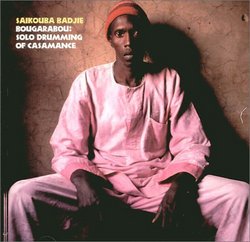| All Artists: Saikouba Badjie Title: Bougarabou Members Wishing: 0 Total Copies: 0 Label: Village Pulse Original Release Date: 6/18/1996 Release Date: 6/18/1996 Genres: Folk, International Music, Pop Styles: Traditional Folk, Africa, India & Pakistan, India Number of Discs: 1 SwapaCD Credits: 1 UPC: 723722427824 |
Search - Saikouba Badjie :: Bougarabou
 | Saikouba Badjie Bougarabou Genres: Folk, International Music, Pop
|
Larger Image |
CD Details |
CD ReviewsRelentless beat! Heartwarming, articulate drum voicings! Phil Rogers | Ann Arbor, Michigan | 07/10/2002 (5 out of 5 stars) "Bougarabou drumming is an anomaly within the general constellation of African drumming. In most parts of Africa, you will find an ensemble of several drummers, each with his/her own drum--together they will play interlocking rhythms. Sometimes there will be ensembles of different types of drums, or different sizes of the same type of drum, or a mixture of both. Rarely does one drummer play more than one hand drum at the same time. Not so in bougarabou drumming, from the Casamance region of southern Senegal, where the most inexperienced drummer might play only one drum, but the better he gets, the more sizes he will play simultaneously, up to as many as four. The drummer, who is a soloist (with the only accompaniment being a bell player), traditionally wears iron rattles attached to his wrists by leather straps.The kind of bougarabou usually seen in the U. S. will remind most people of the djembe, the main similarity between the two being visual. In this country, we usually we see bougarabous constructed/tuned like djembes: the drumhead is attached to the drum's wooden shell with nylon rope using the familiar Malian weave. Saikouba Badjie's drums, however, are constructed using peg tuning, as are many African drums all around the continent, including those of the sabar ensembles of eastern Senegal, and many of the drums native to Ghana and Nigeria. [A different sort of lacing using gut strings or leather thongs is very prevalent in much of eastern and southern Africa.]How the djembe and the bougarabou are different: the djembe [which these days is a nearly omnipresent phenomenon in the U. S.] is goblet-shaped, with a drumhead of goatskin, which gives it its high almost barking type sound. There are only 3 different kind of tones typically played on a djembe. In the area of Africa it's native to (Mali, Guinea, and the eastern part of Senegal), it's supposed to be used more as a support drum, and at certain junctures as a solo instrument. The real meat and potatoes of Malian/Guinean drumming is the dundun ensemble, three deeper sounding cylindrically shaped drums of various sizes which are played with sticks.By contrast, the bougarabou has a drumhead of cow skin, and thus a mellower sound (timbre), more akin to that of the familiar barrel-shaped conga drums, but even more articulate than they, probably due to the particular amplification qualities of its conical shape. There is a plethora of sounds that can be gotten from this drum. Now to the music: this guy can really, really play . . . this should get more than just your toes tapping (and your head spinning?). The man is an absolute virtuoso, and has been at it for a long, long time.Actually, all of the Village Pulse releases are stunning in their detail and the quality of their sound. The only thing I wish is that the singers could be dialed in a bit more, as that element of the music has been downplayed in order to accurately capture the sounds of the drums. Too bad they haven't developed interactive CD's which allow the users to change critical aspects of the mix . . . I'd certainly like to have both 'versions' available, as what we can hear of the singing is excellent."
|

 Track Listings (10) - Disc #1
Track Listings (10) - Disc #1